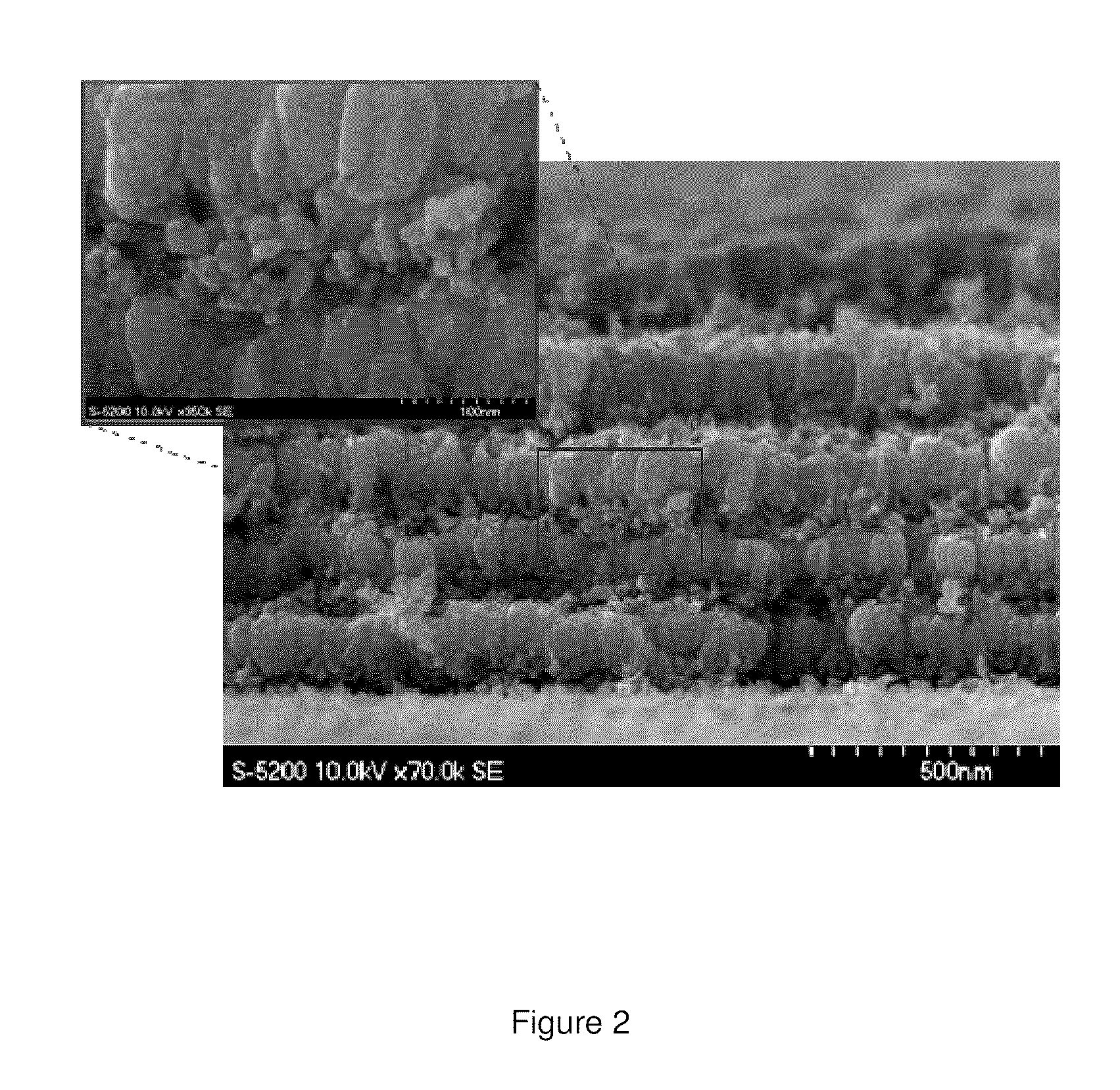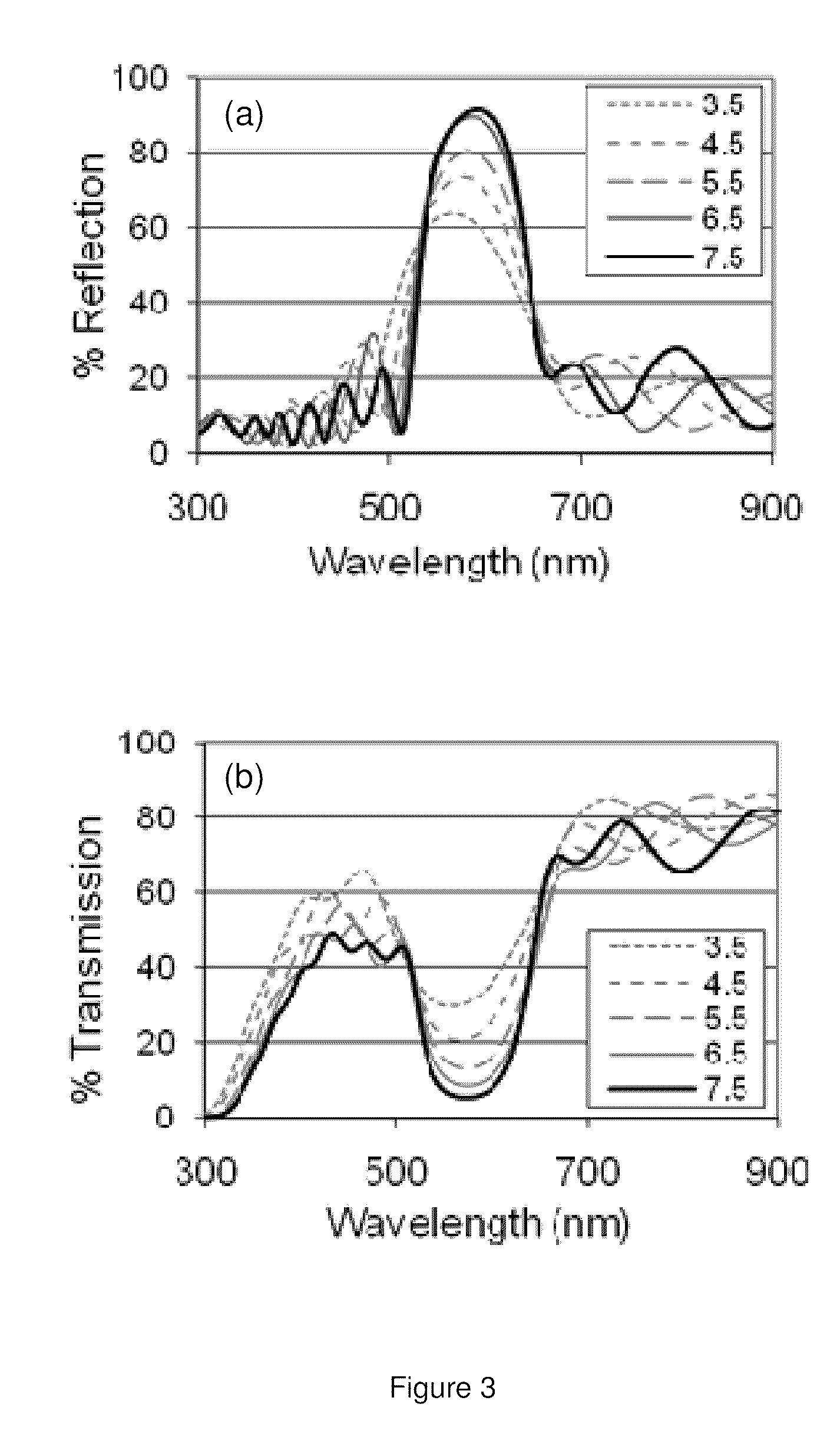Transparent conductive porous nanocomposites and methods of fabrication thereof
a technology of porous glass and composite films, applied in the direction of conductive materials, solid-state devices, non-conductive materials with dispersed conductive materials, etc., can solve the problems of low transmittance of porous glass-ito composite films, complex manufacturing methods, and high cost of manufactur
- Summary
- Abstract
- Description
- Claims
- Application Information
AI Technical Summary
Benefits of technology
Problems solved by technology
Method used
Image
Examples
example 1
Fabrication of Transparent Conductive Nanocomposites, Bilayers and Photonic Crystals
[0101]In order to fabricate mesoporous transparent and conducting films an approximately 100 nm thick nanoparticle film was first prepared from a solution of SiO2 nanoparticles, purchased from Aldrich (Ludox SM-30, 30 wt %) that is diluted in deionised water (3:1 deionized water / Ludox). This solution is subsequently filtered through a 0.2 μm pore Nylon syringe filter before being spin-coated onto a 0.7 mm thick ·2.5 cm×2.5 cm Corning 1737 glass substrate at speed of 3000 rpm for 20 seconds. The SiO2 nanoparticle films are then annealed at 450° C. for 15 minutes in order to evaporate any remaining solvent. Subsequently, small and controlled amounts of ITO are deposited onto the SiO2 nanoparticle films in a custom built sputtering system (Kurt J. Lesker Co.) by RF magnetron sputtering from a ceramic In2O3:SnO2 target (90:10 wt %).
[0102]During the deposition, argon was flowed into the chamber at a rate ...
example 2
Morphology, Optical Transmission and Reflection Spectra of Multilayer Nanocomposite Films and Photonic Crystals
[0107]Experiments were performed for which either about 5 nm, or 10 nm of ITO was sputtered onto the SiO2 nanoparticle films (that is, if the ITO had been sputtered onto a flat substrate the thickness of the film would be approximately 5 nm or 10 nm thick, respectively). This process, wherein a SiO2 nanoparticle film is deposited and subsequently controlled amounts of ITO are sputtered onto the film can be successively repeated in order to build up a film of desired thickness.
[0108]The transmission and sheet resistance of SiO2 nanoparticle films fabricated by performing the aforementioned procedure one, three and five times are shown in FIG. 1. It is interesting to note that the transmission through the Corning 1737 glass substrates that had the nanoparticle films deposited onto them is actually greater than the bare glass substrates. This is because the index of refraction...
example 3
Conductivity of Multilayer Nanocomposite Films
[0113]Conductivity measurements were obtained by depositing two rectangular co-planar aluminum contacts (0.25 cm×0.5 cm), spaced apart by 400 μm, 700 μm, or 1 mm, onto each sample. The current through the films was measured, using a Keithley 6517 electrometer, as different biases were applied across the pair of contacts. The resistivity values are calculated from the sheet resistance measurements using the formula Rs=ρ / t. Where t is the thickness of the photonic crystal and is estimated from the cross-sectional SEM images.
[0114]Referring again to FIG. 1, the resistivity of the silica nanoparticle films that underwent about 5 nm and 10 nm of ITO sputtering is approximately 3×10−1 and 3×10−2 Ω·cm, respectively. In comparison, the resistivity of an ITO film deposited using the same conditions is about 5×10−4 Ω·cm. Also, it can be noted that the resistivity of a SiO2 nanoparticle film that has not been subjected to ITO sputtering was measure...
PUM
| Property | Measurement | Unit |
|---|---|---|
| Pore size | aaaaa | aaaaa |
| Auxiliary magnetic field | aaaaa | aaaaa |
| Thickness | aaaaa | aaaaa |
Abstract
Description
Claims
Application Information
 Login to View More
Login to View More - R&D
- Intellectual Property
- Life Sciences
- Materials
- Tech Scout
- Unparalleled Data Quality
- Higher Quality Content
- 60% Fewer Hallucinations
Browse by: Latest US Patents, China's latest patents, Technical Efficacy Thesaurus, Application Domain, Technology Topic, Popular Technical Reports.
© 2025 PatSnap. All rights reserved.Legal|Privacy policy|Modern Slavery Act Transparency Statement|Sitemap|About US| Contact US: help@patsnap.com



